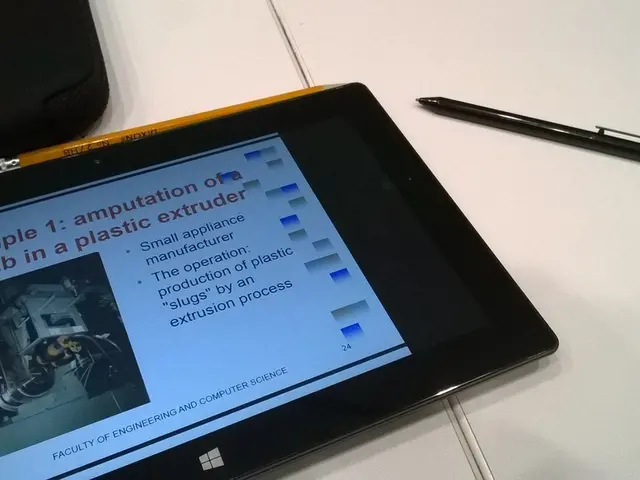Educational Strategies Leveraging Game Elements: Key Components
Gamification in education is revolutionizing the way students learn, making the process more engaging, interactive, and effective. By incorporating elements from video games and other interactive platforms, educators can create a dynamic and immersive learning environment that fosters motivation, retention, and overall success.
Clear Goals and Rules
Setting well-defined goals and rules gives students a clear path to follow and helps them understand what they need to achieve. This structure helps students stay focused and motivated, ensuring they are well-prepared for success [1].
Progress Indicators
Visual markers like points, badges, or levels provide students with a sense of advancement, showing them how far they've come and encouraging them to reach new milestones [1].
Instant Feedback
Immediate responses, whether confirming a correct answer or suggesting to try again, allow students to learn from their mistakes and adjust their strategies on the spot, improving their learning efficiency [1].
Levels and Challenges
Breaking lessons into manageable stages or challenges creates a journey-like learning experience, developing skills such as problem-solving and critical thinking [1].
Rewards and Recognition
Offering rewards—from digital badges to privileges—acknowledges effort and achievement, boosting student morale and encouraging consistent participation [1].
Competition and Collaboration
Leaderboards inspire healthy competition, while team-based goals promote collaboration and peer support, creating a balanced and positive learning atmosphere [1].
Personalisation and Choice
Allowing students to select avatars, learning paths, or missions adds ownership and personal connection to their education, increasing intrinsic motivation [1].
Engagement Boost
Overall, these gamification elements increase student engagement, making learning more interactive and reducing boredom [2].
Motivation through Player Types
Addressing different student motivations by appealing to various player types (such as achievers, socialisers, free spirits) helps design gamified content that resonates with diverse learners [3].
Teacher's Role in Design and Support
Teachers structure the gamified environment, track progress, provide encouragement, and tailor rewards to match both student interests and curricular goals, ensuring gamification supports effective learning [3].
These components create a dynamic, interactive environment that improves motivation, knowledge retention, problem-solving skills, and overall learning outcomes compared to traditional approaches [1][2][3].
Real-World Rewards and Privileges
Points can be tied to real-world rewards or privileges, further incentivizing students to perform well [4].
Collaboration and Teamwork
Collaboration and teamwork are essential skills in both education and the workplace, and gamification provides an effective way to develop these abilities by incorporating group activities and collaborative challenges [5].
Rewards and Incentives
Rewards and incentives can be associated with learning outcomes to motivate students and reinforce positive behaviors, taking various forms such as extra credit, privileges, virtual items, or tangible rewards [6].
Feedback and Reflection
Feedback and reflection are essential components of the learning process, providing students with immediate, action-specific feedback and opportunities for self-assessment to improve and succeed [7].
Leaderboards and Ranking
Leaderboards rank students based on their performance, fostering healthy competition and encouraging students to improve their scores [8].
Achievements and Milestones
Achievements can mark significant educational milestones, such as completing a course or excelling in a project [9].
Enhanced Retention and Understanding
Gamification in education enhances retention and understanding by tapping into students' intrinsic motivations [10].
Quests and Challenges
Quests and challenges transform learning into an immersive adventure, making the learning process more dynamic, engaging, and goal-oriented [11].
Levels and Progression Systems
Levels and progression systems create a well-defined and structured pathway for students, offering them the opportunity to unlock new content, challenges, or privileges as they advance in their learning journey [12].
Narrative and Storytelling
Narrative and storytelling are powerful tools in gamification, transforming the educational experience into an immersive journey by embedding learning content within a compelling storyline [13].
By embracing gamification, educators can create a more engaging and effective learning environment, fostering a love of learning and setting students up for success in their academic and professional pursuits.
[1] Kapp, K. M. (2012). The gamification of learning and instruction: Game-based methods and strategies for training and education. John Wiley & Sons.
[2] Deterding, S., Dixon, D., Khaled, R., Nacke, L. E., & Whiteside, J. (2011). From game design elements to gamefulness: Defining gamification. In Proceedings of the 34th annual Hawaii international conference on system sciences (pp. 1405-1414). IEEE.
[3] Hamari, J. L., & Kinnunen, J. (2014). Does gamification work? A literature review of empirical studies on gamification. Simulation & Gaming, 45(4), 441-465.
[4] Malone, T. W. (1980). Toward a theory of intrinsic motivation in games and play. Psychology Review, 87(4), 337-352.
[5] Johnson, D. W., & Johnson, R. T. (2000). Joining together: Group theory and group development. Allyn and Bacon.
[6] Bandura, A. (1991). Self-efficacy: The exercise of control. Freeman.
[7] Gagne, R. M., Wager, W. W., Golas, P. A., Keller, J. M., & Raju, S. N. (2005). Principles of instructional design. Prentice Hall.
[8] Deci, E. L., & Ryan, R. M. (2000). Self-determination theory and the facilitation of intrinsic motivation, social development, and well-being. American Psychologist, 55(1), 68-78.
[9] Honey, P., & Mumford, A. (1992). The manual of learning styles. Kogan Page.
[10] Kapp, K. M. (2012). The gamification of learning and instruction: Game-based methods and strategies for training and education. John Wiley & Sons.
[11] Prensky, M. (2001). Digital game-based learning. Educational Leadership, 58(7), 6-12.
[12] Squire, K. (2006). The learning game: What education might look like if game design were central. Educational Researcher, 35(7), 349-360.
[13] Gee, J. P. (2003). What video games have to teach us about learning and literacy. Palgrave Macmillan.
- Incorporating education-and-self-development elements, such as well-defined goals, progress indicators, instant feedback, and rewards, helps create a motivated and focused learning environment that fosters student success, following the gamification trend in education.
- Offering a variety of challenges, levels, and quests in an education-and-self-development platform encourages collaboration and teamwork, while addressing different student motivations and fostering a love of learning, ensuring diversity and personalization in the learning process.




